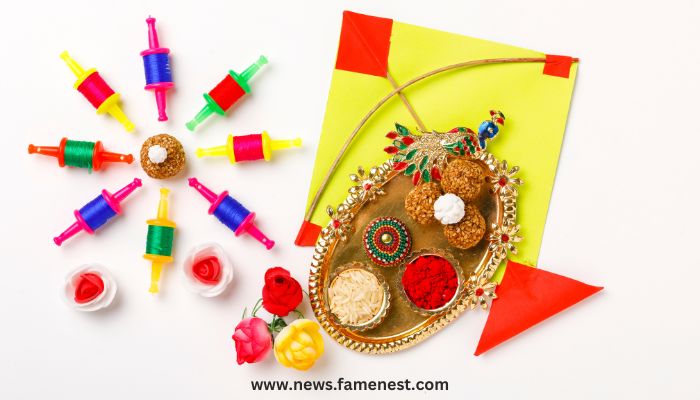Makar Sankranti 2024, a significant festival in Hinduism, holds immense importance during the Poush month, specifically on January 15, 2024. This day witnesses fervent Ganga snan (bath), generous donations, and dedicated prayers, symbolizing liberation from hardships and an influx of prosperity and happiness.
Understanding Makar Sankranti
Makar Sankranti, a celestial event, occurs when the sun enters Capricorn. Known by different names across India, it signifies the end of the winter solstice. In northern India, it’s celebrated as the Khichdi festival, while Gujarat and Maharashtra commemorate it as Uttarayan. Down south, it transforms into Pongal, Lohri in Punjab, and Magh Bihu in Assam.
Why Makar Sankranti is Celebrated
The festival symbolizes the sun’s transition from Capricorn to Aquarius in Hindu and Nepali traditions. Laden with mythological tales, it involves rituals like sacred river baths, prayers, and grand feasts. It’s believed that Lord Vishnu defeated demons on this day, and the Ganga descended from heaven.
Significance of Makar Sankranti 2024
Makar Sankranti holds astrological significance, marking the sun’s transition into Capricorn. Celebrated on January 14 according to the solar calendar, it aligns with the sun’s movement. This festival symbolizes the beginning of a new solar month, intertwined with environmental purity and spiritual cleansing.
Religious and Cultural Importance
According to Hindu scriptures, Suryadev is considered the father of Shani (Saturn), and on Makar Sankranti, the sun visits his son’s abode for a month. Another legend speaks of Lord Vishnu ending the rule of demons on this day, burying their heads beneath the Mandara mountain. This festival heralds the end of the winter season, welcoming the vibrant spring.
The Meaning of Makar Sankranti
Translated, Makar Sankranti signifies the “sun’s shift from one zodiac to another.” This festival enlightens us on the day the sun enters Capricorn.
How Makar Sankranti is Celebrated
Celebrations vary across India and Nepal, involving rituals like river baths, prayers, and hosting feasts. In some regions, kite flying and cultural events take centre stage. Acts of charity, such as donating blankets, warm clothes, sesame seeds, jaggery, and khichdi, are deemed auspicious.
Donations on Makar Sankranti 2024
On this day, donating blankets, warm clothes, dari (a type of mat), shoes, caps, sesame seeds, jaggery, khichdi, and ghee is considered highly auspicious. Scriptural references claim that such acts improve worldly and spiritual realms, akin to performing 10 Ashvamedha Yagnas and donating 1,000 cows.
Activities on Makar Sankranti
- Take a Dip: Start the day with a bath in a sacred river, if possible.
- Sun Salutation: If a river bath is not feasible, mix Ganga water in your bath and offer an arghya to the sun.
- Charity: Extend your generosity to needy people by giving sesame seeds, jaggery, and khichdi.
- Ganga Water Ritual: Sprinkle Ganga water in your home, ensuring purity.
Makar Sankranti 2024 – Lucky Zodiac Signs
- Leo (Singh Rashi): Sun’s Uttarayan brings prosperity, career success, and potential partnerships.
- Aries (Mesh Rashi): Sun entering the 10th house signifies financial growth and career advancements.
- Pisces (Meen Rashi): A favourable period, bringing financial gains, stable relationships, and professional success.
Makar Sankranti Puja Procedure
- Cleanse: Begin by thoroughly cleaning your home.
- Bathing Ritual: Bathe in a sacred river or use Ganga water at home.
- Attire: Wear yellow, considered auspicious, and offer arghya to the sun.
- Chanting: Recite Surya Chalisa and Aditya Hridaya Strot.
- Aarti: Conclude with an aarti, emphasizing the significance of charity.
Frequently Asked Questions (FAQs)
1. When is Makar Sankranti 2024?
Makar Sankranti will be observed on January 15, 2024.
2. Why is Makar Sankranti called Uttarayan?
Makar Sankranti is known as Uttarayan because it marks the sun’s northward journey.
3. What are some traditional dishes prepared during Makar Sankranti?
Traditional Makar Sankranti dishes include tilgul, puran poli, undhiyu, sabudana vada, bhogichi bhaji, and khara pongal.
4. How is Makar Sankranti celebrated in different regions?
Celebrations vary, but common practices include kite flying, cultural events, and acts of charity
